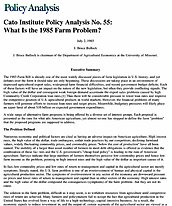The 1985 Farm Bill is already one of the most widely discussed pieces of farm legislation in U.S. history, and yet debates over the form it should take are only beginning. These discussions are taking place in an environment of depressed agricultural export sales, widespread farm financial difficulties, and record government budget deficits. Each of these factors will have an impact on the nature of the new legislation, but often they provide conflicting signals. The high value of the dollar and consequent weak foreign demand accentuate the export sales problems caused by high Commodity Credit Corporation loan rates.[1] Thus there will be considerable pressure to lower loan rates and improve the competitive position of U.S. agricultural products in world markets. However, the financial problems of many farmers will generate efforts to increase loan rates and target prices. Meanwhile, budgetary pressures will likely place an upper limit of about $10 billion on expected government expenditures.
A wide range of alternative farm programs is being offered by a diverse set of interest groups. Each proposal is presented as the cure for what ails American agriculture, yet almost no one has stopped to define the farm “problem” that the proposed programs are supposed to address.
About the Author

This work is licensed under a Creative Commons Attribution-NonCommercial-ShareAlike 4.0 International License.
